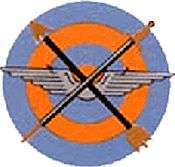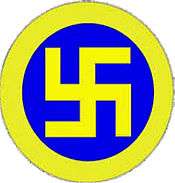55th Fighter Squadron
| 55th Fighter Squadron | |
|---|---|
|
55th FS F-16C Block 50D 91-0375 landing at Shaw in December 2006 | |
| Active |
9 August 1917 – 16 March 1919 15 November 1930 - 18 October 1945 29 July 1946 – 30 December 1993 1 January 1994 – present |
| Country | United States |
| Branch | United States Air Force |
| Type | Fighter |
| Role | OCA-SEAD |
| Part of |
Air Combat Command 9th Air Force 20th Fighter Wing 20th Operations Group |
| Garrison/HQ | Shaw Air Force Base |
| Nickname(s) | Shooters, Fightin' Fifty-Fifth |
| Motto(s) | "Roll 'em!", "Shooters Roll!" |
| Colors | Blue, White |
| Mascot(s) | Wild Weasel |
| Engagements |
Battle of Normandy Battle of the Bulge |
| Decorations |
|
| Commanders | |
| Notable commanders | Gabby Gabreski |
| Insignia | |
| 55th Fighter Squadron emblem |
 |
The 55th Fighter Squadron (55 FS) is part of the 20th Fighter Wing at Shaw Air Force Base, South Carolina. It operates the F-16 Fighting Falcon aircraft conducting air superiority missions.
The squadron is one of the oldest in the United States Air Force, its origins dating to 9 August 1917, being organized at Kelly Field, Texas. It deployed overseas to France as part of the American Expeditionary Forces, as an aero construction[1] squadron at the 3d Air Instructional Center, Issoudun Aerodrome. The squadron saw combat during World War II, and became part of the United States Air Forces in Europe (USAFE) during the Cold War.
History
World War I
The 55th Fighter Squadron’s roots trace back to 9 August 1917. Originally organized as the 55th Aero Squadron at Kelly Field, Texas, by November the squadron was deployed to Issoudun, France. The squadron was demobilized on 6 March 1919, following the war. The squadron was reactivated in November 1930, at Mather Field, California, flying Boeing P-12 aircraft, later joined by DH-4 aircraft in 1931. The squadron moved several times in the next decade, flying the P-26, P-36, and finally the P-40 at Hamilton Field.[2]
World War II
At the beginning of World War II, the 55th sent its personnel to units fighting overseas and continued to train aviators for squadrons in Europe and the Pacific. In May 1942, it was redesignated a fighter squadron and transitioned to the P-39 Airacobra, operating from several locations in the United States before acquiring P-38 Lightnings.[2]
The 55th was in the skies over Europe by August 1943, operating from RAF Wittering, England. The squadron flew 175 combat missions with the Lightning before acquiring the P-51 Mustang in 1944. With the rest of the 20th Fighter Group, the 55th flew daily strafing, long-range-patrol and bomber-escort missions. In June, they provided air cover during the massive allied invasion of Normandy.[2]
As the war progressed, the 55th performed escort and fighter-bomber missions supporting the Allied advance through Central Europe and the Rhineland. In December 1944, they took part in the Battle of the Bulge, escorting bombers to the battle area. The squadron’s 175th and last combat mission in the P-51 was flown in April 1945, the day after American and Soviet forces met at the Elbe River. The 55th was demobilized on 18 October 1945, after the war’s end, but was reactivated on 29 July 1946, at Biggs Field, Texas, flying air power demonstrations and training operations in the P-51.[2]
Cold War

The 55th entered the jet age in February 1948, with the F-84G Thunderjet. In January 1950, it was redesignated the 55th Fighter-Bomber Squadron. The squadron returned to England at RAF Wethersfield in June 1952. The squadron transitioned to the F-100 Super Sabre in 1957 and in 1958 was redesignated the 55th Tactical Fighter Squadron.[2] The 55th moved with the 20th Tactical Fighter Wing to RAF Upper Heyford in June 1970. The next April, the 55th received its first F-111E Aardvark, becoming fully operational in November. Throughout the 1970s and 1980s, the 55th participated in countless North Atlantic Treaty Organization and U.S. exercises and operations, which directly contributed to containment of Soviet threats to Europe.[2]
In January 1991, elements of the 55th deployed to Turkey during Operation Desert Storm. They flew more than 144 sorties, amassing 415 combat hours without a loss. These missions neutralized key facilities throughout northern Iraq and helped to liberate Kuwait and stabilize the region.[2] The squadron was inactivated in December 1993.
Modern era

It was transferred and reactivated on 1 January 1994, to its present home, Shaw Air Force Base, flying the A-10 Thunderbolt II. In July 1996, the squadron transferred its aircraft to Pope Air Force Base, North Carolina, and stood down.[2]
In July 1997, the 55th made history when it stood up as a combat-ready F-16CJ squadron in only 60 days. It has since made numerous deployments to Southwest Asia, continuing to contain the Iraqi threat. In the meantime, the squadron has earned awards and recognition, including the David C. Schilling Award in 1999 and 2000, as well as the Air Force Association Citation of Honor.[2]
In the summer of 2000, the 55th deployed to Southwest Asia for Operation Northern Watch. It followed that deployment with Operation Southern Watch in the fall of 2001, and in the winter of 2002, deployed again in support of Operation Northern Watch. Most recently the 55th deployed in support of Operation Iraqi Freedom in late 2008.[2]
Lineage


- Designated 55th Aero Squadron on 9 Aug 1917
- Re-designated 55th Aero Construction Squadron on 25 Aug 1917[3]
- Re-designated 467th Aero Construction Squadron on 1 Feb 1918[4]
- Demobilized on 16 Mar 1919
- Reconstituted, and redesignated 55th Pursuit Squadron, on 24 Mar 1923
- Activated on 15 Nov 1930
- Re-designated: 55th Pursuit Squadron (Fighter) on 6 Dec 1939
- Re-designated: 55th Pursuit Squadron (Interceptor) on 12 Mar 1941
- Re-designated: 55th Fighter Squadron on 15 May 1942
- Re-designated: 55th Fighter Squadron (Twin Engine) on 30 Dec 1942
- Re-designated: 55th Fighter Squadron, Twin Engine, on 20 Aug 1943
- Re-designated: 55th Fighter Squadron, Single Engine, on 5 Sep 1944
- Inactivated on 18 Oct 1945. Activated on 29 Jul 1946
- Re-designated: 55th Fighter Squadron, Jet, on 15 Jun 1948
- Re-designated: 55th Fighter-Bomber Squadron on 20 Jan 1950
- Re-designated: 55th Tactical Fighter Squadron on 8 Jul 1958
- Re-designated: 55th Fighter Squadron on 1 Oct 1991
- Inactivated on 30 Dec 1993
- Activated on 1 Jan 1994.
Assignments
- U. S. Signal Corps, 28 Aug-Nov 1917
- Third Aviation Instruction Center, Nov 1917
- Aerial Gunnery School, May 1918
- 2d Air Depot, Nov 1918-Feb 1919
- Unknown, Feb-16 Mar 1919
- 2d Bombardment Wing (attached to 20th Pursuit Group), 15 Nov 1930
- 8th Pursuit Group (attached to 20th Pursuit Group), 1 Apr 1931
- 20th Pursuit (later, 20th Fighter) Group, 15 Jun 1932 – 18 Oct 1945
- 20th Fighter (later, 20th Fighter-Bomber) Group, 29 Jul 1946
- Attached to 20th Fighter-Bomber Wing, 15 Nov 1952 – 7 Feb 1955
- Attached to 39th Tactical Fighter Group, 31 Aug – 23 Oct 1990
- 20th Operations Group, 31 Mar 1992 – 30 Dec 1993; 1 Jan 1994 – present
Stations
|
|
Aircraft Operated
|
|
Operations
| Wikimedia Commons has media related to 55th Fighter Squadron (United States Air Force). |
- World War I
- World War II
- Operation Desert Storm
- Operation Northern Watch
- Operation Southern Watch
- Operation Iraqi Freedom
- Operation New Dawn
- Operation Unified Protector
See also
References
![]() This article incorporates public domain material from the Air Force Historical Research Agency website http://www.afhra.af.mil/.
This article incorporates public domain material from the Air Force Historical Research Agency website http://www.afhra.af.mil/.
- ↑ AFHRA
- 1 2 3 4 5 6 7 8 9 10 55 FS Fact Sheet
- ↑ Special Order No. 93, dated 25 August 1917, National Archives, Ft Worth, TX, Subgroup E466, Box 1, File Special Orders 21-31 August 1917.
- ↑ Memo dated 21 August 1918, National Archives, College Park, MD, Subgroup E177, Box 57, File 467th AS AEF.
- 1 2 3 4 5 AFHRA 55 FS Page

